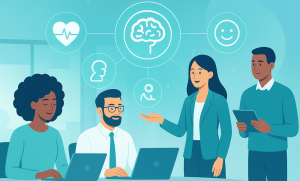The modern workplace is no longer just about productivity, deadlines, and performance metrics. Today, organizations increasingly recognize that the well-being of their workforce plays a critical role in overall business success. Yet, despite widespread awareness of mental health challenges, many companies still struggle to detect early signs of stress, disengagement, or burnout among employees.
This is where real-time sentiment analysis is changing the game. By combining advanced AI tools with organizational support strategies, sentiment analysis offers a proactive approach to identifying mental health needs, ensuring employees feel seen, supported, and valued.
Understanding Real-Time Sentiment Analysis
Sentiment analysis, often referred to as opinion mining, is the process of using AI and natural language processing (NLP) to interpret emotions, tone, and intent behind human communication. When deployed in a workplace context, real-time sentiment analysis evaluates feedback, chat interactions, emails, or even short survey responses to gauge the emotional well-being of employees.
Instead of waiting for annual engagement surveys or exit interviews, organizations can capture employees’ feelings in the moment, allowing for faster intervention. This level of insight is especially important in today’s hybrid and remote environments, where signs of stress or burnout can easily go unnoticed.
Why Mental Health Monitoring Matters
Employee mental health is directly tied to productivity, engagement, and retention. Research shows that workers struggling with stress or anxiety are more likely to take sick leave, underperform, or disengage from their roles. The hidden cost of unaddressed mental health challenges often manifests in absenteeism, reduced morale, and higher turnover rates.
By using sentiment analysis as part of a mental health support strategy, organizations can:
- Identify early warning signs of burnout.
- Understand emotional trends across teams or departments.
- Tailor wellness programs to address specific needs.
- Foster a culture of openness and psychological safety.
How Real-Time Sentiment Analysis Supports Mental Health

1. Early Detection of Stress and Burnout
Sentiment analysis can pick up on subtle linguistic cues that may indicate stress, frustration, or fatigue. For example, consistent use of negative phrasing or disengaged responses in workplace communications can trigger alerts for HR or wellbeing managers.
This makes it possible to provide timely support before issues escalate into burnout.
2. Personalized Mental Health Interventions
By understanding the collective emotional state of employees, organizations can design wellness initiatives that are not generic but personalized. For instance, if analysis reveals rising stress levels in a specific team, managers can introduce AI stress management tools or promote micro-break practices tailored to that group.
This approach ensures that employees receive relevant support that resonates with their actual needs.
3. Continuous Feedback Beyond Annual Surveys
Traditional employee surveys offer valuable insights, but they are often too infrequent to capture the dynamic nature of workplace emotions. Real-time sentiment analysis, on the other hand, provides continuous monitoring, ensuring organizations stay responsive to evolving employee moods.
This shift from reactive to proactive monitoring helps build trust and engagement.
4. Strengthening Remote and Hybrid Workforces
In hybrid and remote work setups, managers can no longer rely on casual observations to gauge employee well-being. Real-time sentiment analysis bridges this gap by offering actionable insights into the emotional health of distributed teams.
It allows leaders to identify employees who may feel isolated or disengaged, ensuring they receive additional support through check-ins, wellness coaching, or access to AI for remote worker wellbeing tools.
The Role of AI in Sentiment Analysis
Artificial intelligence powers sentiment analysis through natural language processing, machine learning, and real-time analytics. Modern AI models can not only detect positive or negative emotions but also differentiate between complex states such as anxiety, frustration, or lack of motivation.
When integrated with platforms like AI-powered wellbeing coaching tools, sentiment analysis creates a closed loop system detecting stress signals and immediately offering real-time coping strategies through digital coaching.
Privacy and Ethical Considerations
While the benefits are immense, organizations must carefully balance sentiment analysis with employee privacy and trust. Transparent communication is key: employees should understand what data is being analyzed, how it is anonymized, and how it will be used to support their well-being rather than penalize them.
Leaders who adopt a people-first approach—prioritizing confidentiality and consent—will find greater success in implementing these tools.
Industry Applications of Sentiment Analysis in Mental Health
Sentiment analysis is proving valuable across multiple industries, especially those with high-stress environments:
- Construction and Manufacturing: Monitoring frontline workers’ emotional states to prevent safety risks and stress-related errors.
- Healthcare: Supporting doctors and nurses with tools that detect burnout risks and offer timely interventions.
- IT and Technology: Managing high workloads and preventing developer fatigue through continuous well-being insights.
- Oil, Gas, and Mining: Ensuring mental resilience for employees in remote or high-pressure job sites.
In each sector, AI-driven sentiment analysis is becoming a critical tool for balancing operational demands with human well-being.
Combining Sentiment Analysis with Wellbeing Tools
Sentiment analysis becomes most effective when integrated into broader wellness strategies. Organizations can connect it with:
- AI stress management platforms that recommend mindfulness or breathing exercises.
- AI coaching assistants like Coach Nova, which offer real-time conversations tailored to stress or anxiety triggers.
- Wellbeing dashboards for HR leaders to visualize trends and act proactively.
- Micro-break prompts that encourage healthier work habits throughout the day.
Together, these create a robust mental health ecosystem that is proactive, personalized, and scalable.
Future of Sentiment Analysis in Employee Well-Being
The future of workplace wellness will be increasingly data-driven. Real-time sentiment analysis is not just about detecting stress—it is about shaping cultures where mental health is a core value.
As AI evolves, we will see:
- Greater accuracy in detecting nuanced emotional states.
- Deeper integration with wearable devices for stress monitoring.
- More personalized coaching interventions delivered in real time.
- Industry-specific wellness frameworks powered by AI analytics.
Organizations that adopt these innovations early will not only improve employee health but also gain a competitive advantage by cultivating more resilient, engaged, and motivated workforces.
Conclusion
Supporting employee mental health requires more than occasional wellness programs or annual surveys. It demands continuous listening, proactive care, and timely intervention. Real-time sentiment analysis delivers exactly that—helping organizations identify stress, prevent burnout, and build healthier workplaces.
When paired with tools like AI-powered coaching, AI for mental wellbeing, and stress management AI, sentiment analysis empowers businesses to prioritize both productivity and humanity.
In today’s evolving workplace, caring for employee well-being is no longer optional—it is a strategic necessity.







